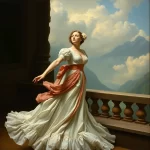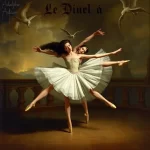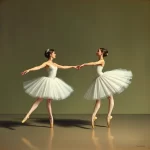Ballet: La Tarantella (Pasquale Borri, 1865)

Introduction
Ballet: La Tarantella, choreographed by Pasquale Borri in 1865, is a captivating one-act ballet that has enchanted audiences for over a century. The ballet, set to a lively and evocative score, captures the essence of Italian folklore and the vibrant spirit of the tarantella dance. Premiering in 1865, this ballet has since become a staple in the repertoire of many ballet companies worldwide.
Pasquale Borri, a renowned choreographer of his time, collaborated with a talented composer to bring this folkloric tale to life. The ballet’s plot revolves around the traditional belief that the tarantella dance could cure the bite of the tarantula spider, blending elements of romance, drama, and cultural tradition into a mesmerizing performance.
Historical Background
Creation and Development
La Tarantella was created during a period of significant cultural and artistic development in Europe. The mid-19th century was a time when ballet was evolving, with choreographers and composers experimenting with new forms and themes. The inspiration for La Tarantella came from Italian folklore, particularly the belief that the energetic tarantella dance could cure the venomous bite of the tarantula spider.
Pasquale Borri, known for his innovative choreography, collaborated closely with the composer to ensure that the music and dance were perfectly synchronized. This collaboration was crucial in creating a ballet that was both musically and visually compelling. The ballet’s creation was also influenced by the Romantic movement, which emphasized emotion, nature, and folklore.
Premiere and Reception
La Tarantella premiered on June 15, 1865, at the Teatro alla Scala in Milan, Italy. The initial reception was overwhelmingly positive, with both critics and audiences praising the ballet for its lively choreography, engaging music, and captivating storyline. The ballet quickly gained popularity and was performed in various theaters across Europe.
Notable early performances included revivals in Paris and London, where the ballet continued to receive acclaim. The energetic and vibrant nature of the tarantella dance, combined with the dramatic storyline, made La Tarantella a favorite among audiences and critics alike.
Synopsis of the Ballet
La Tarantella is a one-act ballet that tells a captivating story rooted in Italian folklore. The ballet opens with a lively village scene, where the villagers are celebrating with music and dance. The central plot revolves around a young woman who is believed to have been bitten by a tarantula spider. According to tradition, the only cure for the bite is to dance the tarantella with great energy and passion.
The young woman’s lover, along with the villagers, joins in the dance, hoping to cure her. The ballet features several key moments, including the dramatic entrance of the tarantula spider, the intense and passionate tarantella dance, and the eventual cure of the young woman. The ballet concludes with a joyous celebration, as the villagers rejoice in the young woman’s recovery.
Musical Composition
Composer’s Role
The composer of La Tarantella played a crucial role in bringing the ballet to life. The music, characterized by its lively rhythms and evocative melodies, perfectly complements the energetic choreography. The composer drew inspiration from traditional Italian folk music, incorporating elements of the tarantella dance into the score.
Notable pieces within the score include the opening village scene, the dramatic tarantella dance, and the celebratory finale. Each piece is carefully crafted to enhance the narrative and emotions of the ballet, creating a seamless blend of music and dance.
Musical Themes and Motifs
The music of La Tarantella features several recurring themes and motifs that enhance the storytelling. The tarantella dance theme, characterized by its fast tempo and rhythmic patterns, is a central motif that recurs throughout the ballet. This theme is used to convey the urgency and intensity of the dance, as well as the joy and celebration of the villagers.
Other musical themes include the dramatic entrance of the tarantula spider, marked by dissonant chords and eerie melodies, and the tender love theme between the young woman and her lover. These themes help to create a rich and dynamic musical landscape that supports the ballet’s narrative.
Famous Recordings and Performances
Over the years, La Tarantella has been recorded and performed by numerous ballet companies and orchestras. Iconic recordings include performances by the Bolshoi Ballet and the Royal Ballet, both of which have brought their unique interpretations to the ballet. These recordings capture the energy and vibrancy of the music, making them a valuable resource for both dancers and audiences.
Choreography and Dance
Choreographer’s Vision
Pasquale Borri’s vision for La Tarantella was to create a ballet that was both entertaining and culturally significant. His choreography reflects the lively and energetic nature of the tarantella dance, with fast-paced movements, intricate footwork, and dynamic group formations. Borri’s innovative use of space and movement helped to bring the story to life, creating a visually stunning performance.
Signature Dance Numbers
Key dance numbers in La Tarantella include the opening village scene, where the villagers engage in traditional dances, and the central tarantella dance, which is the highlight of the ballet. The tarantella dance is characterized by its fast tempo, intricate footwork, and energetic movements, making it a challenging and exciting piece for dancers.
Other notable dance numbers include the dramatic entrance of the tarantula spider, where the dancers use expressive movements to convey fear and tension, and the celebratory finale, where the villagers rejoice in the young woman’s recovery.
Notable Interpretations
Over the years, different productions of La Tarantella have brought their unique interpretations to the choreography. Some productions have emphasized the folkloric elements of the ballet, incorporating traditional costumes and set designs, while others have taken a more contemporary approach, using modern choreography and staging techniques.
Notable interpretations include productions by the Bolshoi Ballet, which emphasized the dramatic and emotional aspects of the story, and the Royal Ballet, which focused on the technical and artistic elements of the choreography.
Characters and Roles
Main Characters
- The Young Woman: The central character who is believed to have been bitten by a tarantula spider. Her role is characterized by expressive and dramatic movements, reflecting her struggle and eventual recovery.
- The Lover: The young woman’s lover, who joins in the tarantella dance to help cure her. His role is marked by passionate and energetic movements, reflecting his love and determination.
Supporting Characters
- The Villagers: The villagers play a crucial role in the ballet, participating in the dances and celebrations. Their movements are lively and energetic, reflecting the festive atmosphere of the village.
- The Tarantula Spider: The tarantula spider is portrayed by a dancer using expressive and dramatic movements to convey fear and tension.
Famous Dancers
Over the years, many notable dancers have portrayed the roles in La Tarantella. Famous dancers include Anna Pavlova, who brought her unique grace and expressiveness to the role of the young woman, and Rudolf Nureyev, whose passionate and dynamic performance as the lover captivated audiences.
Cultural and Artistic Impact
Influence on Ballet and Dance
La Tarantella has had a significant influence on ballet and dance, inspiring other choreographers and composers to explore folkloric themes and traditional dances. The ballet’s innovative choreography and lively music have made it a favorite among dancers and audiences, contributing to the development of ballet as an art form.
Cultural Significance
The ballet’s cultural significance lies in its portrayal of Italian folklore and traditions. La Tarantella has been referenced in literature, film, and other media, highlighting its enduring appeal and cultural relevance. The ballet’s themes of love, struggle, and celebration resonate with audiences, making it a timeless classic.
Legacy and Revivals
La Tarantella continues to be performed and celebrated today, with major revivals and reinterpretations by leading ballet companies. Modern adaptations have brought new perspectives to the ballet, incorporating contemporary choreography and staging techniques while preserving the essence of the original work.
Iconic Productions
Historic Productions
Historic productions of La Tarantella include performances by the Bolshoi Ballet and the Royal Ballet, both of which have brought their unique interpretations to the ballet. These productions featured renowned dancers, directors, and set designers, contributing to the ballet’s enduring legacy.
Contemporary Productions
Recent productions of La Tarantella have taken a more contemporary approach, incorporating modern choreography and staging techniques. These productions have brought new life to the ballet, making it accessible to a new generation of audiences while preserving its cultural and artistic significance.
Production Design
The production design of La Tarantella plays a crucial role in bringing the story to life. Traditional productions often feature elaborate sets and costumes that reflect the folkloric elements of the ballet, while contemporary productions may use minimalist designs to emphasize the choreography and music. Lighting design is also an important aspect, creating mood and atmosphere that enhance the performance.
Critical Reception and Reviews
Initial Critical Response
The initial critical response to La Tarantella was overwhelmingly positive, with critics praising the ballet for its lively choreography, engaging music, and captivating storyline. The ballet’s premiere at the Teatro alla Scala in Milan was met with enthusiastic applause, and subsequent performances continued to receive acclaim.
Modern Reviews
Contemporary critics and audiences continue to appreciate La Tarantella for its vibrant energy and cultural significance. Modern reviews often highlight the ballet’s innovative choreography and evocative music, as well as its timeless themes of love, struggle, and celebration. The ballet’s enduring popularity is a testament to its artistic and cultural impact.
Fun Facts and Trivia
Behind-the-Scenes Stories
One interesting behind-the-scenes story involves the creation of the tarantula spider costume. The costume, designed to be both dramatic and realistic, required intricate craftsmanship and attention to detail. Dancers portraying the spider often had to undergo extensive rehearsals to perfect their movements and convey the fear and tension associated with the character.
Notable Performers
Notable performers associated with La Tarantella include Anna Pavlova, Rudolf Nureyev, and Margot Fonteyn, all of whom brought their unique talents and interpretations to the ballet. These dancers’ performances have become iconic, contributing to the ballet’s enduring legacy.
Trivia
- La Tarantella is based on the traditional belief that the tarantella dance could cure the bite of the tarantula spider.
- The ballet’s premiere at the Teatro alla Scala in Milan was a major cultural event, attracting audiences from across Europe.
- The tarantella dance, characterized by its fast tempo and rhythmic patterns, is a central motif in the ballet’s music and choreography.
Conclusion
Summary of the Ballet’s Importance
La Tarantella is a significant work in the world of ballet, known for its lively choreography, engaging music, and cultural significance. The ballet’s portrayal of Italian folklore and traditions, combined with its innovative choreography and evocative music, has made it a timeless classic that continues to captivate audiences.
Final Thoughts
La Tarantella is a testament to the enduring power of dance and music to tell compelling stories and convey deep emotions. Its themes of love, struggle, and celebration resonate with audiences, making it a beloved work in the ballet repertoire. Whether you are a seasoned ballet enthusiast or a newcomer to the art form, La Tarantella is a must-see performance that offers a rich and rewarding experience.
FAQ
What is the central theme of this ballet?
The central theme of La Tarantella is the traditional belief that the energetic tarantella dance can cure the bite of the tarantula spider. The ballet explores themes of love, struggle, and celebration through its lively choreography and evocative music.
Who are the main characters in this ballet?
The main characters in La Tarantella are the young woman who is believed to have been bitten by a tarantula spider and her lover, who joins in the tarantella dance to help cure her. The villagers and the tarantula spider are also important characters in the story.
What is the most famous dance number in this ballet?
The most famous dance number in La Tarantella is the central tarantella dance, characterized by its fast tempo, intricate footwork, and energetic movements. This dance is the highlight of the ballet and a favorite among audiences.
How long does a typical performance of this ballet last?
A typical performance of La Tarantella lasts approximately 30 to 40 minutes, as it is a one-act ballet. The performance includes several key dance numbers and dramatic moments that tell the story in a concise and engaging manner.
Are there any modern adaptations of this ballet?
Yes, there are modern adaptations of La Tarantella that incorporate contemporary choreography and staging techniques. These adaptations bring new perspectives to the ballet while preserving its cultural and artistic significance.
Why is this ballet considered important in the history of dance?
La Tarantella is considered important in the history of dance because of its innovative choreography, engaging music, and cultural significance. The ballet’s portrayal of Italian folklore and traditions, combined with its lively and energetic dance numbers, has made it a timeless classic that continues to influence choreographers and dancers.





